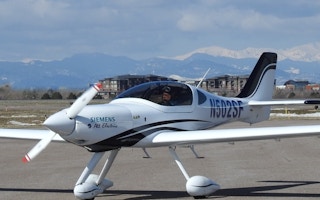This fall, teen Swedish climate activist Greta Thunberg will be touring the United States, attending two different climate summits in New York and Brazil to speak with world leaders. But the hardest part of the trip may not be wrangling foreign dignitaries, motivating crowds, or making high-profile TV appearances. Thunberg has sworn off flying, making her journey across the Atlantic a challenge. “The tricky part is getting there without flying,” Thunberg tweeted in June. “I haven’t solved that yet.”
Thunberg isn’t alone in shunning airplanes. The AP reported last month that a growing movement of climate activists in Europe and North America are shunning air travel in an attempt to reduce their personal carbon footprints.
Every round-trip transatlantic flight emits enough CO2 to melt 30 square feet of Arctic sea ice. Emissions from airplanes have doubled over the past 20 years, and air traffic will double by 2035, driven by a growing middle class in countries like China and India.
“
The noise issue and the pollution issue make us a really welcome member of the community.
George Bye, president and founder, Bye Aerospace
But the future of travel could become easier on the planet if airlines start going electric. The transition is already underway, with big names like Boeing, Rolls-Royce and GE all working on electric plane projects. Other companies around the world are moving at a rapid pace to secure their own programs.
But battery-powered planes face more challenges than battery-powered cars and trucks. Weighty batteries can be a challenge for planes that need to be as light as possible and are used to shedding weight mid-flight as they burn through fuel reserves. Also, planes can’t touch down in the middle of a trip to recharge, rendering long-distance travel over oceans a daunting task.
Shorter flights, therefore, are an ideal first target to tackle in terms of cutting emissions: they use as much as 25 per cent of their total fuel during takeoff and landing. And technology is quickly pushing the boundaries of what was previously thought possible in terms of building these planes.
“With cars, we know that battery technology is getting better and better,” said George Bye, president and founder of electric aviation company Bye Aerospace. “The batteries are getting lighter and thinner and they’re lasting longer and longer. And that technology trend is important for airplanes, too.”
The Paris air show is the largest showpiece for the aviation industry — and at the annual event last month, electric flight was front-and-center. British budget airline EasyJet said last year it would have a fleet of electric planes in operation by 2030. Just before the airshow, the Wall Street Journal reported that EasyJet was in competition with other low-cost European airlines to show their customers that they were slashing emissions.
Israeli company Eviation Aircraft announced in Paris that they plan to sell their electric model to US regional airline Cape Air. Passengers on Cape Air’s flights to the Massachusetts Cape will be able to fly on electric planes by 2022, the company said.
Electric flights aren’t just the climate-conscious thing for airline companies to explore — they could also be big cost-savers. The cost of fuel accounted for somewhere between a quarter and third of airlines’ budgets in recent years. Making matters worse, a planned switch by cruise ships and other vessels to cleaner fuel may squeeze fuel prices even higher for airlines.
By saving money on fuels, electric planes will not only help airlines save money, they could solve its pilot shortage. “It’s as expensive to become an airline pilot as it is to become a doctor or a lawyer,” Bye said, explaining that 80 per cent of trainees drop out before their training is complete. One of the cost-prohibitive components of becoming a pilot is paying for the long hours of trainingn needed to accrue required hours of flight time.
Bye Aerospace’s aircraft offers a solution. It costs just $3 per hour to power Bye’s electric eFlyer model, compared to the $50 per hour it costs to fuel a conventional plane. The fuel savings will make it cheaper to train on the small, low-weight electric aircraft.
The company is applying to sell the first electric airplane cleared for use in aviation training.
“Of course, electric aircrafts haven’t been done before,” Bye said. “So we are literally working with the FAA every day as we go through this brand new process.” FAA refers to the Federal Aviation Administration.
If other companies follow in Bye Aerospace’s footsteps, Bye predicts it will make life better for both passengers and people who live near airports. Cities with airports will become quieter and cleaner. “The noise issue and the pollution issue make us a really welcome member of the community,” Bye said.
This story was published with permission from Nexus Media.








